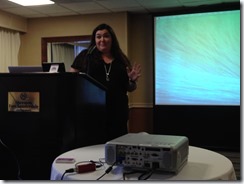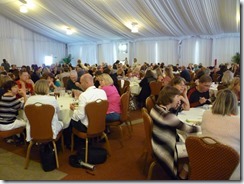Marketing and Selling Your Books with Sophia Knightly
At a recent meeting of the Florida Romance Writers, Inc., USA Today and New York Times bestselling author Sophia Knightly shared her promotional strategies. A two-time Maggie award finalist and a P&E Readers’ Poll finalist, she is traditionally published by St. Martin’s Press, Kensington, and Samhain Publishing. Her popular indie published Tropical Heat Series books have consistently been on Amazon bestseller lists and sold over 100,000 copies.

Sophia started off by mentioning 7 book promotion strategies:
1. Image and Promotional Strategies
2. Website and Social Media
3. Conferences and Book Signings
4. Promotion and Advertising
5. Collaborative Initiatives
6. Publishing Sales Infrastructure
7. Measuring and Tracking Performance
Start by defining and creating your brand. Consider your style and marketing image. Personalize your message as much as possible. Toot your horn in your signature line and create a tagline for your brand.
Packaging the image includes your book covers, series branding, bundled box sets, stock photos. Label your work a “short novella” if it is one so readers know what to expect. Sophia recommends Gilded Heart Designs and Kim Killion as designers. For herself, she uses Pikasa for graphic design.
You’ll want to put out a newsletter featuring your author news, events, contests, and appearances.
A street team can be helpful in creating buzz, cheerleading, and reviews. Send ARCs to your team with a deadline for reviews. In return, you can provide swag and online parties. Sophia currently has 33 people in her team. She takes members off after six months if they don’t participate. She’ll show team members her new covers, ask them questions on a message board, and provide swag and a welcome package that may include T-shirts, postcards, bookmarks, trading cards, magnets, and Emery boards. She holds reader contests and gives appreciation gifts of chocolates or a gift basket at special events where she appears in person.
Build your story and themes. For example, if there’s a dog in your story, put a picture of the dog online and feature him in your Facebook posts. Create a holiday message from the dog. Sophia did a Facebook page for her dog character “Romeo”, but you could use any other secondary character as long as you do steady posts.
Attend industry conferences, hold contests, and do signings. Sign up for Autography with iPad and Authorgraph on Kindle.
“The more books you put out there, the more you’ll sell.” Check out the Author Network and Indie Romance Ink which have lots of resources.
Embed your book blurb for the sequel in the back of a book. Use vendor specific links and a newsletter sign-up link in your back material.
Promotion and Advertising Sites
Check out paid ad sites such as Book Bub , E-reader News Today, Kindle Books and Tips, Kindle Book Blast, and Book Gorilla.
Do Facebook sponsored posts for five dollars a day when you want to announce a new release, have an online party, or get people to sign up for your newsletter.
Collaborative Initiatives
Sophia reached the USA Today bestseller list when she combined her two Tropical Heat Series books, Wild for You and Sold on You in a boxed set and reduced the price to $0.99 for a limited time sale.
She made the New York Times bestseller list through a collaborative effort with 6 other authors in the Lucky 7 Bad Boys Boxed Set. Lucky 7 Bad Boys Boxed Set has been on the USA Today bestseller list for three consecutive weeks since publication in early March.
Pricing
Price according to the word count. Run sales often and bundle books in a series. Offer occasional freebies or make things Permafree. Have a loss leader pricing, like the first book in a series for $2.99, while subsequent titles are $3.99. You can drop the price on sale to $.99 for a limited time like 1 to 2 weeks. Sophia will offer a box set for $3.99 and then she’ll put it on sale for $.99.
Be current on models and trends. Go back further on royalty-free sites to find images, or the same image might be used too often by other authors.
Website and Social Media
Facebook will tell you which posts are doing better. Use visual images with Facebook and Pinterest. Put up photos of fun stuff to connect with readers. If a post doesn’t have an image, less people will read it. Like your own post. The more Likes, the more people who will see it.
Use Twitter, HootSuite, Goodreads, Instagram, and do giveaways. Offer short videos. Put a video in your newsletter inviting people to your Facebook party. Interview members of your lifeboat team on video and invite people to enter your group contest.
Have a contest on Facebook giving away e-books, fun stuff that women love, and gift cards. Network by joining book groups on Facebook. Twitter is better in the morning, late afternoon, or after dinner. Have your buy links everywhere. Have a tab on your Facebook author page for your mailing list sign-up.
A lot of readers are on Wattpad. It’s a free site where you can put up the first few chapters of your book including buy links.
“Write more books. Release them often.” She believes you should have a product out every three months. It’s the number one way to sell more books and build a large readership.
<><><>
Follow Sophia Online:
Website: http://www.sophiaknightly.net/
Amazon Author Page: http://www.amazon.com/Sophia-Knightly/e/B00663POSI/














